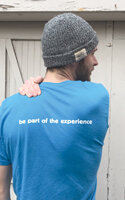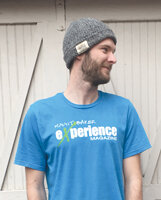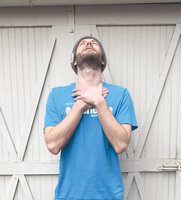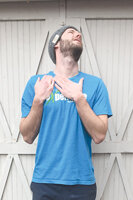 Cameron Hamilton in the Mt. Baker backcountry. Brad Andrew photo.
Cameron Hamilton in the Mt. Baker backcountry. Brad Andrew photo.By Luca Williams
Do you remember your first days learning to snowboard? I started with farm boots and my boyfriend’s 161-centimeter snowboard (did I mention that I am only 5'4"?). The bindings didn’t even cinch tight around my boots. After a few humiliating days, I bought myself some new snowboard boots and drove my buddy, Ira Urie, up to a small ski area in Wisconsin. We got to the top of the lift and all of a sudden Ira said, “See ya,” and took off, leaving me at the top of the lift to really learn to snowboard.
So there I was at the top of the hill, catching my heel edge and falling right on my butt over and over again, too nervous to transfer my weight onto my toe-side edge. Finally, I became courageous enough to make a toe-side turn. After many hours of hard work and concentration, I began to link turns and it felt like heaven. Soon after, I began “flying” down the mountain, when suddenly … whack – toe-side turn gone wrong, face plant, scorpion, whiplash. I know you snowboarders can feel my pain and laugh with me. I sure wish I knew then how and what to stretch after those crashes.
Another kind of neck pain can arise due to the asymmetry of snowboarding. As you are riding downhill you must turn your head right or left depending on your stance. When you constantly turn your head right (for goofy footers), the muscles that contract keep getting stronger while the muscles that stretch keep stretching and stretching for hours every day. Slowly, after years of snowboarding, your head stays turned ever so slightly.
Snowboarding is not the only asymmetrical activity; daily life comprises a multitude of activities that are not symmetrical. There’s nothing wrong with that, so long as we practice awareness and unwind afterward. The following activity is to build that awareness. After that, try some stretches that help the muscles and fascia of your head, neck and spine to return home after snowboarding, scorpions and whiplash.
Put your right hand gently on your left shoulder between the shoulder blade and the spine and notice what happens when you turn your head right. Feel how the shoulder blade moves away from the spine (this is a very subtle motion that you can feel at the very end). These are the muscles that overstretch.

 Now, place your right hand gently on the left side of the front of your neck. Feel how a muscle pops up into your hand as you turn right. This is a muscle that contracts to turn your head right. Now ask yourself how much you love snowboarding and how many hours you have spent turning in this direction toward the fall line. Eventually your head, neck and shoulder blade get the idea that you want them that way even when you aren’t snowboarding.
Now, place your right hand gently on the left side of the front of your neck. Feel how a muscle pops up into your hand as you turn right. This is a muscle that contracts to turn your head right. Now ask yourself how much you love snowboarding and how many hours you have spent turning in this direction toward the fall line. Eventually your head, neck and shoulder blade get the idea that you want them that way even when you aren’t snowboarding.

 1) One of the most simple neck stretches you can do for yourself anywhere and
1) One of the most simple neck stretches you can do for yourself anywhere and
everywhere is to just simply turn your head right and left. If you are a goofy-footer, spend more time turning left and looking left. If you are regular, turn and look right more often. Do this gently without the intention of stretching hard. You are just trying toremind your nervous system, muscles and fascia that you want to turn both directions.
2) Place your hands crossed on your chest right below your collarbones. Gently hold the skin down as you look up to the sky. Now move your hands over to the right and side  bend your head left while lifting your chin to the sky. Do the opposite, move your hands to the left side, then side bend your head right and lift your chin to the sky. This stretch really gets some of the muscles of the front of the neck that we ignore while begging our friends to rub our neck and shoulders. While you are stretching, notice where you get more pain. But more importantly, notice which movements are more restricted. These are the muscles that really need stretching.
bend your head left while lifting your chin to the sky. Do the opposite, move your hands to the left side, then side bend your head right and lift your chin to the sky. This stretch really gets some of the muscles of the front of the neck that we ignore while begging our friends to rub our neck and shoulders. While you are stretching, notice where you get more pain. But more importantly, notice which movements are more restricted. These are the muscles that really need stretching.

Luca Williams is a certified rolfer in Glacier. She helps snowboarders, skiers and other outdoor enthusiasts get aligned and out of pain. Website: lucasrolfing.com Blog: movingwithgravity.wordpress.com